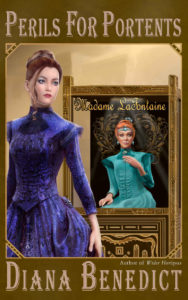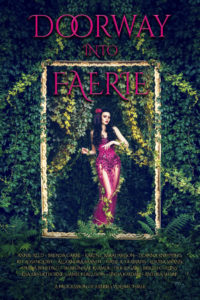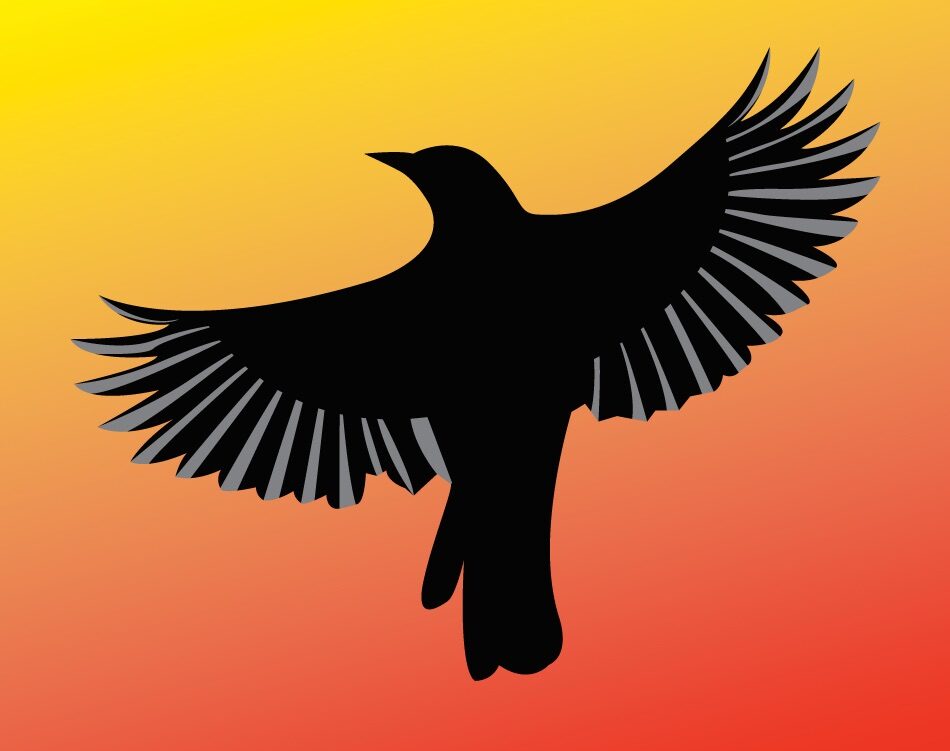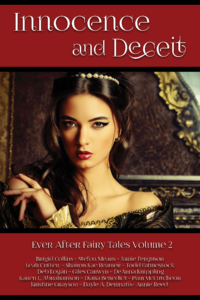Interview: Diana Benedict on “City of Nowhere in the World”
“City of Nowhere in the World” is in Innocence and Deceit, the second volume in the Ever After Fairy Tales anthology series.
Enter the magical, unpredictable, wonderful world of fairy tales!
Meet Diana Benedict!
Diana Benedict, aka Thea Hutcheson, lives in Colorado with a collection of books, cats, the boxes and other accouterments the cats entertain themselves with, and an understanding partner. She loves pulling the magical, fairy tale aspect of storytelling into her stories.
“City of Nowhere in the World”
Korshan falls and cuts her knee on a hidden rock in “City of Nowhere in the World.” Korshan seeks the shaman to ask for salve for her knee, not realizing what magical adventures await her.
Excerpt
Korshan steeled herself to stand tall and not quake with the fear that rattled her legs and made her belly clench down tight. It was one thing to see an old man and call him a shaman. It was another to see him wearing his cloak and hear and see the magic in front of you. She looked away lest he see the terror in her eyes and think she wasn’t worthy of his help, or shouldn’t have been trusted with eggs in the first place.
“Come with me, little sun,” he said, waving his staff at her.
She followed him around back of the hut, past the goat pen and the garden to the edge of the barley field, emerald against the dark mud.
“Fetch me a stick and a withy,” he said. Korshan went and picked up a reed and found a long supple twig, and brought them to him.
He sang over them and waved his staff and danced a bit. The lion’s eyes blazed like embers in a smithy’s fire and the stick grew and split, grew and split, while the withy stretched like a long rope and wound around and around, the whole thing growing into a ladder that reached far up into the sky.
“Climb that and look for your eggs,” the shaman commanded.
Korshan stared at the ladder standing straight up and reaching toward the sky. She looked back down the road where she had come, and then back at the ladder. How could this lead to her eggs?
—from “City of Nowhere in the World” by Diana Benedict
The Interview
What inspired you to write “City of Nowhere in the World?”
I read this tale in an anthology of tales of brave girls from around the world and love the nonsensical connections that pulled the reader through the story. But the original was like many fairy tales—bare boned. I just knew Korshan needed more flesh on her story bones to do her tale justice.
In a previous interview, you said the stories you write with fairy tale elements that are special to you. What is it about these stories that gives you such a strong connection to them?
I love the magic. I also love that people and animals go through those adventures and come out successful because of their own wits and innate talents. I have always felt like I had to depend on myself to get what I want, and have made my way in the world successfully because I pursued what I wanted, sometimes in the face of people telling me I couldn’t or shouldn’t for various reasons.
Where is “City of Nowhere in the World” set, and what is it that you like about this geographical area?
The story is set in Mesopotamia. I have always been drawn to the Middle East–Greece, Anatolia, and Crete are my favorites, but the earliest cities were built along the Euphrates and Tigres rivers. They were busy figuring out that they could farm and feed themselves, creating time to do other things, like build cities and learn how to live in them. The Bronze Age is my favorite time period. People believed in magic and gods, and people could be magicians and speak to gods. Wonderful things happened back then, when the world was really just getting started in ways that modern people can touch and relate to. That is the best magic.
In “City of Nowhere in the World” Korshan Ilibasha is a strong and clever protagonist, like many of the characters you write about. What do you enjoy about working characters like this into your stories?
They give me a chance to play with lots of situations, and I can give the characters many chances to have adventures where they find their strengths, leverage their fears, and come out better whether they really get what they want or not. It also lets me see into myself and find out wonderful things about myself and my hopes and dreams.
 Perils for Portents is a steampunk novel about a haunted fortune telling machine. Do you plan on writing anything else in this world?
Perils for Portents is a steampunk novel about a haunted fortune telling machine. Do you plan on writing anything else in this world?
Yes, I have several other novels planned for this series. They are a bit further down the production schedule, but Francie Wolcott will get married, and she and Madame LaFontaine, the ghost that haunts the machine, will have several adventures, both in America and abroad. Those stories take place in a very special and difficult time for women just before the turn of the 19th century, and Francie will find her own way through them.
Diana Benedict is one of your pen names. What are the others, and how do you decide which name to write under?
I also write under Thea Hutcheson and Theda Hudson.
When I get an idea for a story, I explore who the characters are, the setting, and the theme. What I find for answers determines who gets credit.
 Diana Benedict mostly gets the stories about young and new adults. She also wrote King of the Air, which appears in Doorway into Faerie: Sixteen Tales of Magic and Enchantment (A Procession of Faeries Book 3), which is about a woman in her thirties. She is older than Diana usually writes, but the story was so darn beautiful, she just begged to be the author.
Diana Benedict mostly gets the stories about young and new adults. She also wrote King of the Air, which appears in Doorway into Faerie: Sixteen Tales of Magic and Enchantment (A Procession of Faeries Book 3), which is about a woman in her thirties. She is older than Diana usually writes, but the story was so darn beautiful, she just begged to be the author.
Thea Hutcheson writes science fiction and fantasy that feature adult characters. She gets to tell all the kinds of stories I was devouring and dreaming of as I grew up and continue to contemplate as an adult.
Theda Hudson writes romance, often with a spicier edge and many times featuring lesbian characters. If I have an idea about an aspect of sexuality or relationships, Theda gets to explore it.
Tell us about your cats!
Thanks for asking! We have four cats. They are all rescues. Muncher, Tom, and M all were born under or on our deck, and Ed Gumji came from the Alley Cat Rescue. Muncher is nearly fourteen now, and a “white on the bottom with a gray hooded cloak” cat. She is my partner’s cat. She only loves him and has seen him through leukemia and bladder cancer. Me she will tolerate to feed and empty the cat box, and allows an occasional pet, but mostly she gives me the stink eye and a hiss, just on general purposes.
Ed Gumji is my fraidy cat. He is a buff and cream tabby who had a really horrible start in life. He had to wear a sweatshirt because he had no body fat to speak of and the minute you put it on, he became the brokeback cat. They told me he was six weeks old when I adopted him, but he was really six months old since his fangs came in shortly after I got him. His baby fangs didn’t fall out and he had to have surgery to remove them, just the start of his dental issues. He had ringworm, internal parasites, and as suffered an ongoing battle with irritable bowel syndrome. He’s twelve now and, for the last year, he only eats oven roasted chicken, which I buy as whole chickens and cut up into meal-sized packets for him, and vacuum seal for freshness. Oh, yes, and Friskies for dinner even though it’s like Kitty McDonald’s, but it’s one of the few other things he will eat. He was a wonderful uncle to Tom and M, whom we rescued when they were four weeks old.
Tom and his two siblings were born in the kitty condo we made for the feral cats to birth in so they were safe. When the momma cats would wean the kittens, we would trap the lot of them and get them spayed/neutered and vaccinated, and return them home where they took up their catly lives, coming back for food and fresh water as they wanted.
But something happened to this momma and one of her kittens. Tom was very talkative and we could hear him meowing from the kitty condo, even with the deck door shut. We went to look and these two adorable kittens were in there. We watched for another day, but Momma didn’t came back. My partner said, “If they eat food, we’re bringing them in.”
I thought of Muncher and Ed Gumji, but how could I resist these cuties? They did lick up baby food so we brought them in and bottle fed them. We cleaned their little bottoms and put them to bed at night in a scale model tent from Target. When the time came, introduced them to kitten food. That is super fun to watch if you ever get the chance.
Ed thought we were doing a terrible job of grooming them and he took over those duties plus, he played with them. Tom looked very much like the Big Bad Daddy Tom in the neighborhood–a thick, soft, all-white coat with an ashy mark on his forehead.Tom’s mohawk, as we called the mark, faded, but he turned out to have a blue left eye and green right eye.
His sister, M, is clearly related to Muncher, much to Muncher’s disgust, because she has the same white lower half, gray hooded cloak, and the same faint white stripe over her hips. But she has the tabby “M” on her forehead, hence her name. She also has a long, lemur-like tail and she fetches, bringing the toy mouse to you and asking politely, but insistently for you to throw it. She and Tom are both seven now, but we still call them the kids.
So, now we have four cats and they are all lovely and funny, with interesting personalities and quirks. And, yes, I am halfway to being a crazy cat lady!
What story (or stories) are you working on now, and what’s fun about what you’re writing?
Theda Hudson just finished a lesbian urban fairy tale that is the second novel in a series. It is a tale based on the Grimm’s fairy tale, “The Crystal Orb”. But it is so much more. There is magic, destiny, mystery, an enchanted princess in a castle, true love, giants, and a magic hat that will take you wherever you like. It is fun because I get to transpose the fairy tale onto modern life and twist the tale elements into new shapes.
I am also working on a fae short story for Diana Benedict about a reluctant queen. I got to do a lot of research about Iron Age Ireland. I love research. I like to do a lot, and yes, it can be a rabbit hole, but what treasures you can find! The research gems find their way into the story in interesting ways and informs the characters, making them fully formed with views and needs and beliefs all their own.
Once that story is finished I will write the third in a time travel series for Thea Hutcheson. This one takes place just before the last time Lake Missoula, an ice age glacial lake in northern Idaho, flooded. It was an epic flood, changing the topography of the land all the way to the Pacific Northwest. The main characters are comprised of two couples, one a Bronze Age Cretan prince and a near future woman, the other a 1980s forensic anthropologist and a Bronze Age African shamaness, who had their own novels already, plus one demi-god whose alter shape is a cat. They are charged with saving Ice Age animals and people from the flood, and shepherding them into a pocket universe for a goddess who loves her creations too much to let them die. Little do they know that Chaos believes that fate should not be meddled with and has agents of his own to enforce his beliefs. They not only must learn how to work as a team, but confront the forces of Chaos as they try to save elephants and tigers and bears from being swept away in a flood of biblical proportions.
About Diana
Diana lives in a small suburban Colorado city a mile away from where she grew up. She loves studying magic and history and will take any opportunity to combine them into a good story. She once tried to work a spell inspired by a tale her great aunt told her and has always felt lucky that it only turned her fingers green for a week.
Find Diana
Website ~ BookBub ~ Amazon ~ Goodreads
Find Innocence and Deceit!
Amazon ~ Barnes & Noble ~ Kobo ~ Apple Books ~ Books2Read ~ Goodreads


